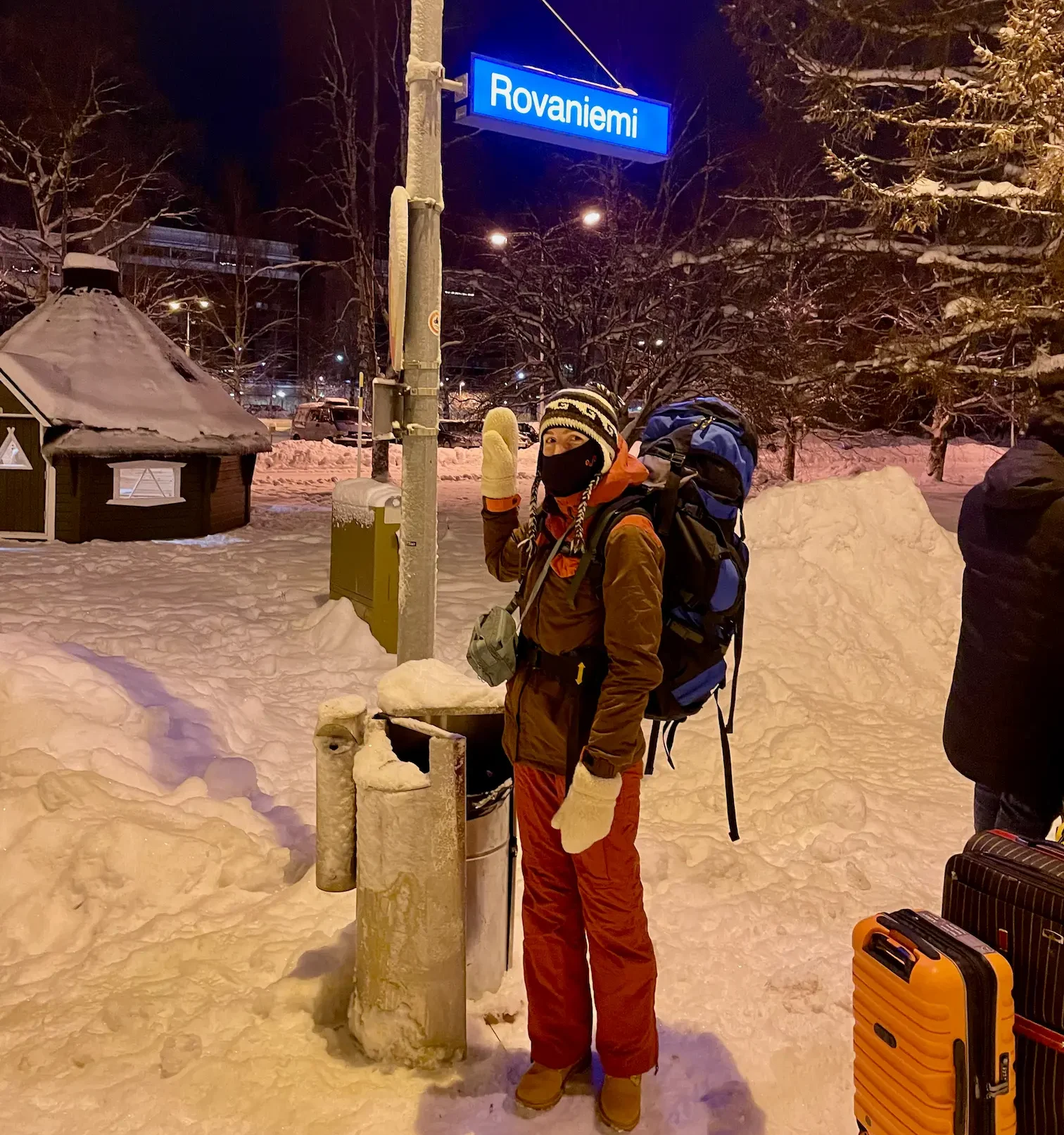Rovaniemi, the official hometown of Santa Claus and the gateway to Finnish Lapland, sits roughly 800 km north of Finland’s bustling capital, Helsinki. Whether you’re chasing the Northern Lights, planning a husky‑sledding adventure, or simply craving a taste of Arctic wilderness, the journey itself can become part of the story.
Helsinki offers a surprisingly diverse set of transport options for the trek north: a scenic train ride, a budget‑friendly bus, a quick flight, or the freedom of a road trip by car.
Each mode carries its own rhythm, cost profile, and set of practical considerations. Below we break down the four main ways to get to Rovaniemi from Helsinki, weigh their pros and cons, and then dive deeper into the two most popular choices—plane versus train—before answering the questions most travelers tend to ask.
What You'll Find In This Post:
1. Getting from Helsinki to Rovaniemi by Train
Overview
Finland’s rail network is operated primarily by VR (Valtionrautatiet). The “Santa Express” runs daily between Helsinki Central Station and Rovaniemi, covering the distance in roughly 8–10 hours depending on the departure time and whether you choose a direct service or a connection via Tampere.
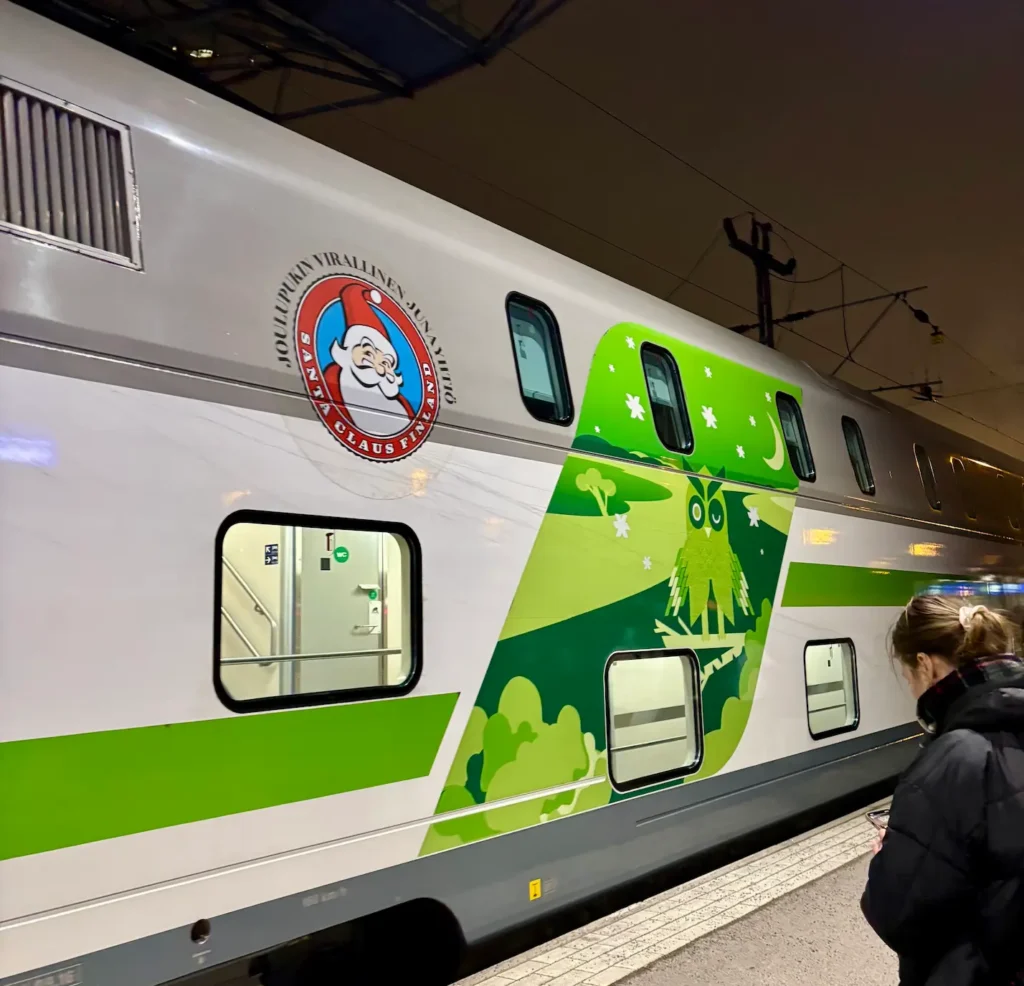

Our Experience: We’ve taken this option twice, once with a 10-month-old. While there are trains operating during the day, we chose the night train both times. That way, not only does the journey go by faster, but you also save on accommodation for the night.
You can buy a standard seat, but we recommend opting for the sleeper cabins. Though not big, they can easily fit two people (+baby/toddler) – you just have to be a bit creative with storing your luggage. That way you can rest and begin your arctic adventure with full energy the next morning.
😊 Pros
- Scenic experience—windows let you watch lakes, forests, and the fading daylight turn into twilight if you take the day train. During the night you might catch a glimpse of the auroras if you’re lucky.
- Comfort & space—roomy seats, power outlets, free Wi‑Fi (though not very reliable), a dining car serving hot meals and cold beer and optional sleeper cabins.
- City‑center to city-center—depart from Helsinki Central Station and arrive at Rovaniemi’s main railway station, both within walking distance of hotels and other transport links.
- No luggage fees—standard allowance of up to two pieces (30 kg each), ideal for ski gear or bulky winter clothing.
- Kids travel for free – Kids below the age of 10 travel for free in sleeper cabins provided that you share a bed. This works quite well with younger children, as the beds are about 90 cm wide.
- Eco-friendly—far lower CO₂ emissions per passenger kilometer than flying or driving.
🙁 Cons
- Longer travel time—even the fastest direct service takes about 8 hours, and most of them about 10-11.
- Limited frequency—only a few departures per day, especially outside the peak winter season.
- Potential winter delays—heavy snow or icy tracks can cause cancellations or slower journeys, though VR generally manages these well, and both of our trains were on time even though we traveled at the depth of winter.
- Higher price for premium seats—first-class or sleeper cabins can approach the cost of a short‑haul flight. This difference, though, usually disappears if there is more than one person traveling and you book early enough, as the sleeper cabins always include 2 beds and you pay per cabin, not per bed.
2. Getting from Helsinki to Rovaniemi by Plane
Overview
Finnair, Norwegian, and sometimes low‑cost carriers such as Ryanair operate direct flights from Helsinki‑Vantaa Airport (HEL) to Rovaniemi Airport (RVN). Flight time is a swift 1 hour 15 minutes, with up to 6 departures per day during the high season (December–February) and fewer in shoulder months.
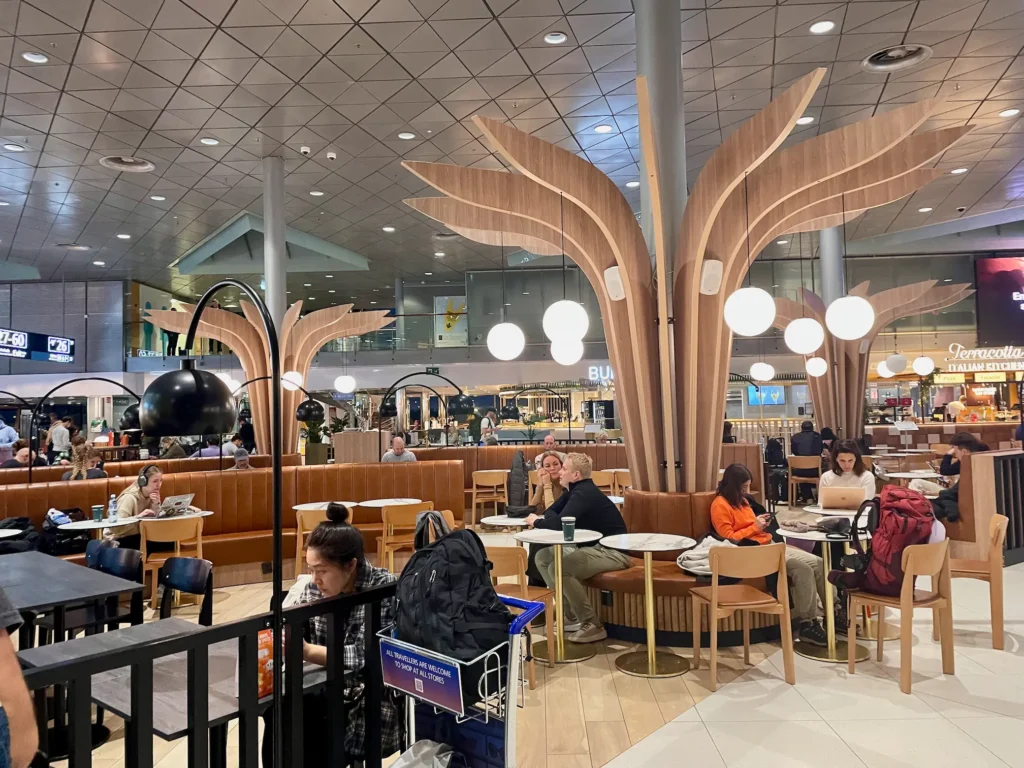
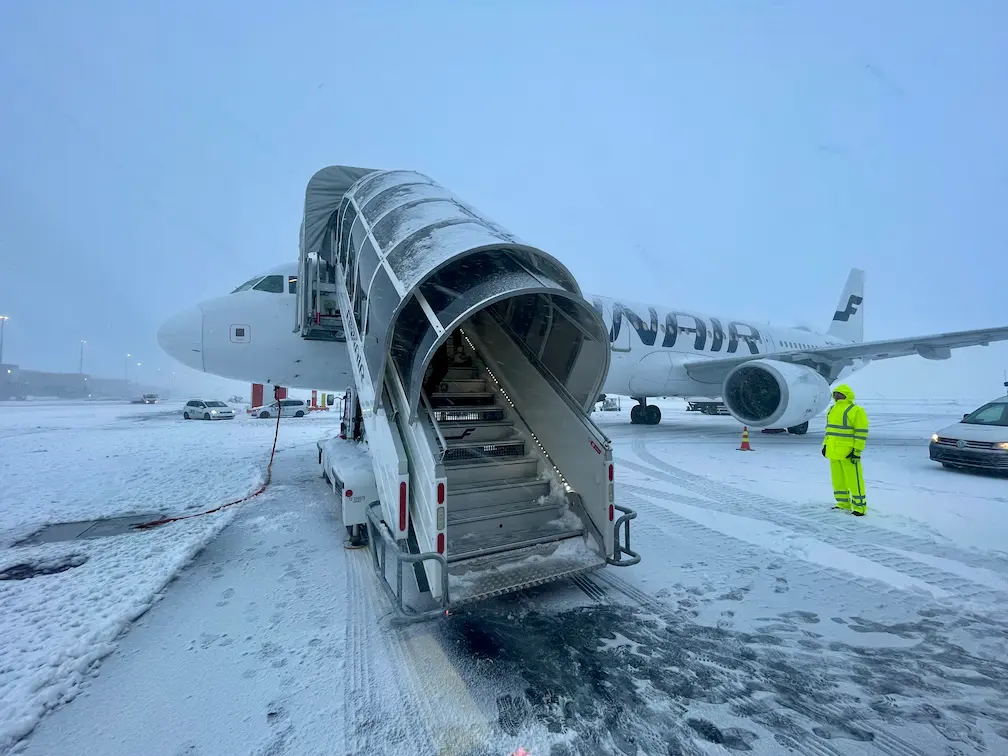
Our Experience: We did this once, as the total cost of flying from Germany to Rovaniemi via Helsinki was cheaper than a flight to Helsinki and then the overnight train. There is something to be said about how smooth the whole journey was – we arrived in Rovaniemi before we knew it, which was a new experience after taking the night train twice before.
Helsinki Airport is very well organized, so even if somewhat big, it was easy to navigate inside the terminal. We had a couple of hours to kill between flights, so we got to walk around the halls, check out the shops, and enjoy the gastronomy. We really loved the wooden flooring and furniture – it makes the whole experience much cozier!
😊 Pros
- Speed—flight time is just 1 hour 15 minutes, freeing up the majority of your vacation for activities.
- High frequency—multiple daily flights during peak season give you flexibility in scheduling.
- Convenient airport locations—both Helsinki-Vantaa and Rovaniemi airports are well connected to their city centers by train, bus, or taxi.
- Minimal baggage hassle—generous carry-on allowance; checked bags are inexpensive for larger items.
🙁 Cons
- Higher cost—round-trip tickets typically range from €80 to €150, especially during the holiday rush.
- Airport logistics—security, boarding, and possible delays add extra time, making door‑to‑door travel closer to 3–4 hours.
- Limited luggage for ski gear—checked-bag fees apply for oversized equipment, increasing overall expense.
- No discounts for kids—If traveling with kids above two, you’ll have to pay the same price for their seat on the plane.
- Environmental impact—air travel produces significantly more CO₂ per passenger than rail or bus.
- Weather‑related cancellations—winter storms can ground flights, requiring last‑minute re‑booking.
Where to stay? Make your trip magical with these unique stays in Lapland 👇
8 Unique Stays for Your Lapland Adventure
3. Getting from Helsinki to Rovaniemi by Bus
Overview
Several coach operators—including OnniBus, Matkahuolto, and ExpressBus—run routes between Helsinki and Rovaniemi. The journey typically lasts 12–14 hours, with an overnight departure being the most common. Buses leave from the Kamppi or Sörnäinen bus terminals and arrive at Rovaniemi’s central bus station, a short walk from the city centre.
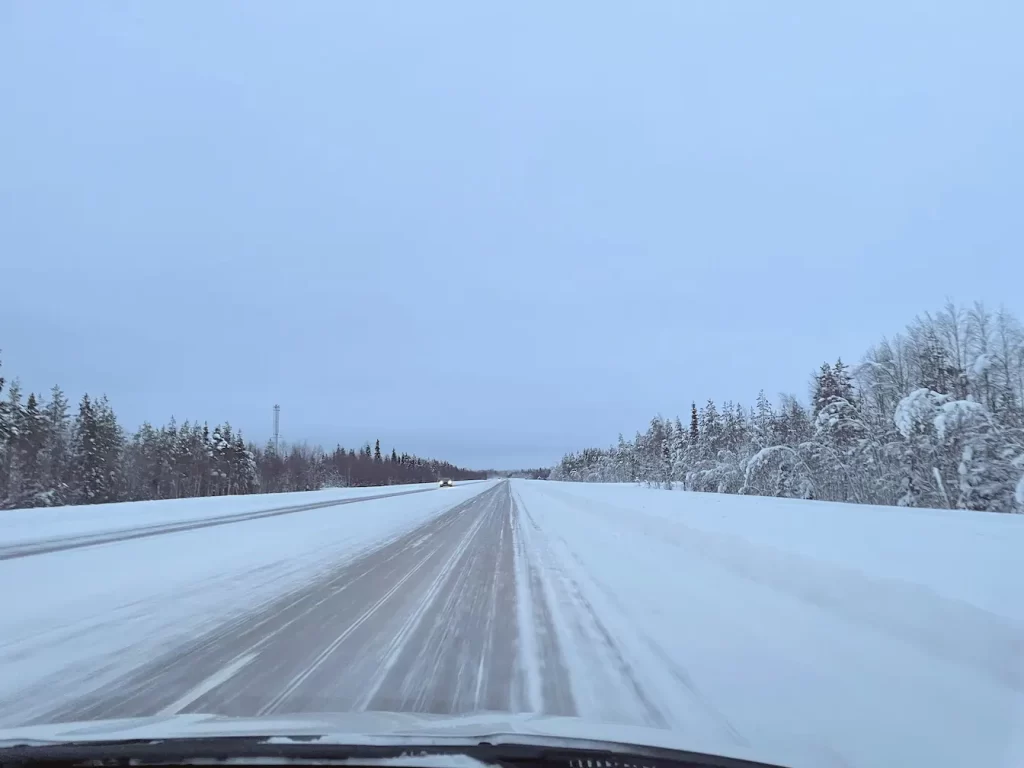
Our Experience: Although we haven’t used the bus for such a long journey in Finland, we have used Matkahuolto for shorter trips from Rovaniemi and the buses, staff, and overall journey experience were very nice.
😊 Pros
- Budget-friendly—tickets often start at €45–€60 return when booked early.
- Frequent promotions—operators run sales during off‑peak months.
- Direct night service—like the overnight trains, overnight buses let you sleep while you travel, saving a night’s accommodation and delivering you to Rovaniemi in the morning.
- Simple booking—tickets available online, via mobile apps, or at the terminal with instant e‑tickets.
- Extra luggage—typically one large suitcase plus a small carry‑on with many companies allowing ski or snowboards for free.
🙁 Cons
- Lengthy journey—12–14 hours on the road, which can be tiring and cuts into sightseeing time.
- Limited comfort—seats are reclinable but not as spacious as train seats; legroom can be tight for taller travelers.
- Fewer amenities—usually only Wi‑Fi and power sockets; onboard food service is minimal.
- Weather sensitivity—snowstorms can cause road closures or significant delays, especially on highway sections crossing lake districts.
4. Getting from Helsinki to Rovaniemi by Car
Overview
Driving from Helsinki to Rovaniemi is a classic Finnish road trip, covering roughly 800 km via the E75 highway. The drive takes 9–10 hours without stops, but most travelers break it up over two days, staying in towns like Kemi or Oulu. Rental cars, personal vehicles, or even electric cars are all viable options.
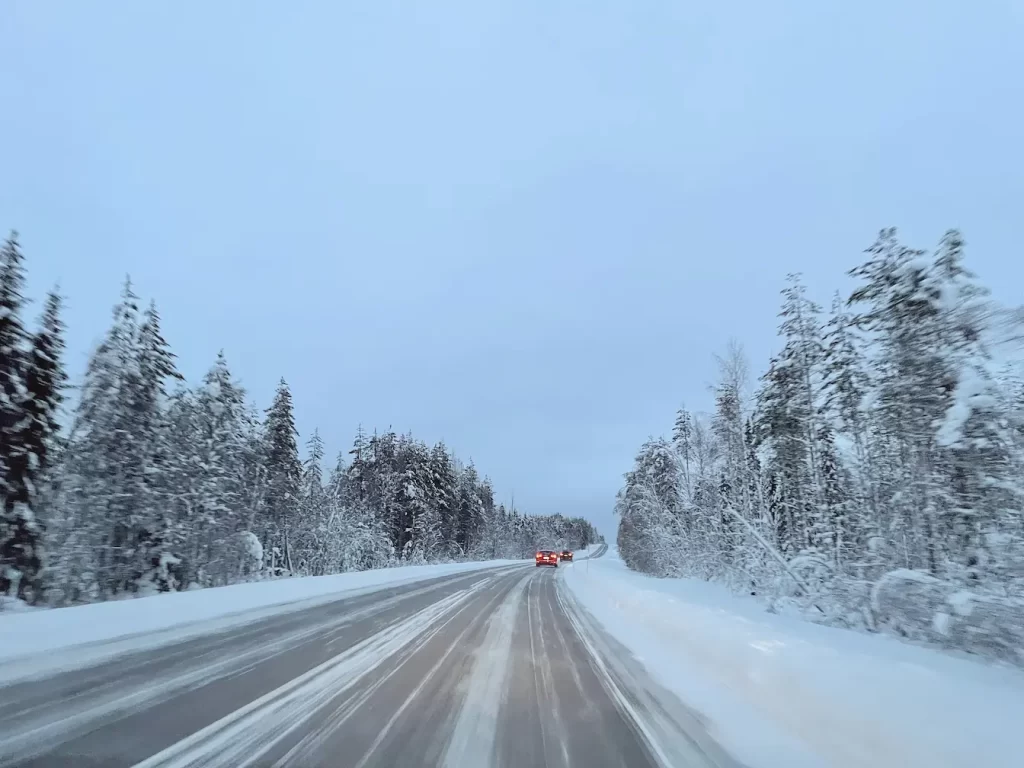
Our Experience: We always tend to travel in winter, so we haven’t dared embark on this epic journey with a car. However, we have rented cars in Rovaniemi to be more flexible, and we never book a car before comparing prices on DiscoverCars.com.
😊 Pros
- Ultimate flexibility—stop whenever you like to photograph a lake, explore a town, or chase the aurora.
- Scenic detours—you can easily divert to attractions such as Kuopio, the Kokkola archipelago, or Oulanka National Park.
- Luggage freedom—no weight limits beyond your vehicle’s capacity, perfect for ski gear, camping equipment, or family suitcases.
- Cost-sharing—fuel and rental costs can be split among passengers, making it economical for groups.
- Road trip experience—the drive itself becomes a memorable adventure, especially when you encounter Finnish winter landscapes or the occasional reindeer on the road.
🙁 Cons
- Winter driving challenges—snow, ice, and limited daylight demand experience, winter tires (your rental car will be equipped with winter tires by law), and sometimes chains; accidents are more likely.
- Fuel expenses—long distances and cold‑weather fuel consumption can add up, especially with diesel price fluctuations.
- Time commitment—even at a brisk pace, you spend almost a full day behind the wheel, reducing activity time at the destination.
👇 Don’t Embark on Your Epic Road Trip Before Checking This Out 👇
7 Tips for Driving in Finland in Winter
Plane vs. Train: Which Wins?
Both the plane and the train dominate the conversation for most travelers heading from Helsinki to Rovaniemi. Deciding which is “best” hinges on three core factors: time, budget, and experience.
1. Time Efficiency
- Plane: The fastest door‑to‑door option, even after accounting for airport procedures, is roughly 3–4 hours total. If you have a tight itinerary—say, a three‑day weekend trip—the flight lets you maximize on‑site activities.
- Train: Even the quickest direct service still requires 8–10 hours. That’s a full day spent traveling, although by choosing a night train, you save on accommodation and travel during the night, so the loss of time is not so extreme.
💡 Bottom line: Choose the plane when every hour at the destination counts. Opt for the train if you can afford a slower start and value a stress‑free, scenic ride.
2. Cost Considerations
- Plane: Prices fluctuate heavily with seasonality. In peak winter (December–January), tickets often exceed €120 round‑trip, while low‑season fares may dip to €70. Adding luggage fees for ski gear can push the total higher.
- Train: Standard second‑class tickets hover around €20–€60 round-trip year-round. First-class or sleeper cabins (they start as low as €50 per cabin if you’re lucky and buy early) raise the price but still stay competitive with many flight options, especially when you factor in the lack of extra baggage fees or a toddler.
💡 Bottom line: For budget‑conscious travelers, the train generally offers better value, particularly if you’re comfortable with standard seating.
3. Travel Experience
- Plane: Offers speed but little immersion. You’ll see the landscape only from a window seat for a brief moment. The experience feels transactional—check in, board, land.
- Train: Turns the journey into part of the adventure. You glide past frozen lakes, pine forests, and small towns, with the chance to stretch, walk the aisles, or chat with fellow passengers. The onboard café serves Finnish pastries, and you can work or read.
💡 Bottom line: If you cherish the journey itself as a cultural vignette, the train wins. If you view travel as a means to an end, the plane is more pragmatic.
Recommendation
Choose the train if you:
- have time
- are on a budget
- love train journeys
- are concerned about the environment
Choose the plane if you:
- are on a weekend getaway
- money is not a concern
- travel light
- want more time at the destination
Closing Thoughts
Whether you glide across the sky, roll along the rails, cruise the highways, or settle into a comfortable coach seat, each path from Helsinki to Rovaniemi tells a slightly different story. The plane delivers you swiftly to the Arctic frontier, perfect for time‑pressed explorers. The train invites you to savor Finland’s wintry heart, turning transit into a scenic interlude. Buses and cars fill the niche for budget travelers and road‑trip enthusiasts alike.
Whichever mode you choose, the magic of Rovaniemi awaits—snow‑capped forests, reindeer‑led sleigh rides, and the timeless charm of Santa’s village. Pack warm layers, keep an eye on the aurora forecast, and let the journey become part of the adventure you’ll recount for years to come. Safe travels!
Frequently Asked Questions about getting from Helsinki to Rovaniemi
How far in advance should I book tickets?
For trains, booking 1–2 months ahead secures the lowest fare and guarantees a seat, especially on the popular “Santa Express.” Flights often see price drops 3–6 weeks before departure, but during the Christmas season it’s safest to book at least 1 month early.
What’s the best time of year to travel?
December–February offers the classic snowy wonderland and the highest chance of seeing the Northern Lights. Late September–October provides milder weather, fewer crowds, and spectacular autumn colors, while the midnight sun in the summer might offer an amazing road trip experience.
Can I bring my ski equipment on the train?
Yes—standard baggage allowance covers two pieces up to 30 kg each, which comfortably fits a pair of skis and boots in your sleeper cabin. No extra fee is required. If you like, you can also use the luggage car and store them there for €5 per item.
Are there direct buses from Helsinki to Rovaniemi?
Most long‑distance coaches require a transfer in Oulu or Jyväskylä. The truly direct overnight service runs only a few times per week, so check the timetable carefully.
Is there Wi‑Fi on the train?
VR offers free Wi‑Fi on most long‑distance services, though speeds can vary. It’s sufficient for checking emails, browsing travel guides, or streaming music.
Do I need a passport to travel within Finland?
No, domestic travel does not require a passport. A valid ID (national ID card or driver’s licence) is sufficient for train, bus, and domestic flights.
Check our other posts about Lapland and Rovaniemi
Discover the most unique stays in Lapland—from glass igloos and snow hotels to private islands. Compare options, prices & book your Arctic adventure today.
Where To Stay In Rovaniemi? The Ultimate Guide For Any Budget
Where to stay in Rovaniemi? From dreamy glass igloos to cozy cabins and budget stays—find the perfect Lapland escape for every style and wallet!
